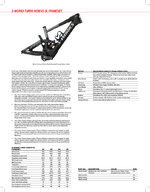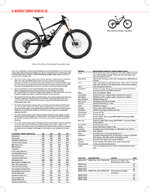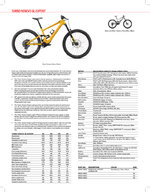The Specialized Kenevo SL is an all-mountain / downhill oriented full suspension electric bike with a "super light" SL motor co-developed by Specialized and the German auto manufacturer MAHLE. The bike is said to be 12lbs (5.4kg) lighter than the standard Turbo Kenevo that uses the Brose S motor and higher capacity battery pack. I've covered the SL drive system on all of the other Specialized models in recent years, including the Creo road bikes, Vado commuter models, Levo cross country, and Como cruisers. It's one of my favorite motors in the ebike space right now because it offers a good amount of power, is natural in the way it responds, and is visually attractive and lightweight. The Turbo Kenevo SL is available in four frame sizes and two colors per skew (S-Works and Expert), I've attached the official sell sheets and press kit below, which include more technical details. Pricing is set at $8,500 for the S Works frameset only (where you add wheels, brakes, a fork, handlebar, and all touch points) or $15,000 for the complete SW build. For the lower level Expert build, the price is $4k less at $11,000 USD. Highlights of this new model include adjustable steer tube angle, the updated TCU2 information hub (Turbo Connect Unit display panel that the new Turbo Levo models also have), and long travel 170mm Fox Float air suspension. Specialized is at the forefront of ebike technology, in my opinion, and their massive dealer network makes it easy to get fitted and stay riding with great post-purchase support... but the prices reflect this. Just like Turbo Levo models, the Turbo Kenevo is a Class 1 model offering pedal assist up to 20mph (32km/h) in North America. Europe may see 15.5mph (25km/h) top speeds based on local laws. Here's their official website https://www.specialized.com/ and I'd love to hear your thoughts below, especially if you own the original Turbo Kenevo or plan to buy the new SL!
Flow Mountain Bike Video Review
MTBR Video Review
EMBN Electric Mountain Bike Network Video
While I haven't reviewed this electric bike myself, I have covered the other SL models from Specialized, as well as the original Turbo Kenevo and I wanted to provide some insights and open things up for your feedback. I hope providing several sources, with varying perspectives, allows everyone to come to their own conclusions. Sometimes short reviews and those created by shops only cover the good aspects and can come off like a commercial, so I've tried to be neutral and objective with these insights:
Pros, things that stand out as good:
Flow Mountain Bike Video Review
MTBR Video Review
EMBN Electric Mountain Bike Network Video
While I haven't reviewed this electric bike myself, I have covered the other SL models from Specialized, as well as the original Turbo Kenevo and I wanted to provide some insights and open things up for your feedback. I hope providing several sources, with varying perspectives, allows everyone to come to their own conclusions. Sometimes short reviews and those created by shops only cover the good aspects and can come off like a commercial, so I've tried to be neutral and objective with these insights:
Pros, things that stand out as good:
- There are very few all mountain or downhill long-travel full suspension electric mountain bikes to begin with, and most of them are quite heavy. This is because the frame needs to be sturdy, and the longer suspension adds material. Most of the ones I've seen either use Bosch, Shimano, or Brose mid-drive units and have 500 watt hour or greater battery packs. By comparison, the Kenevo SL appears to be just as rugged, but a lot lighter and stealthier. This can help you transport the bike on your car rack, ascend trails, and improve handling and stopping.
- Most of the competing products that I've seen are offered in three sizes and only one color. By contrast, Specialized has two builds for this bike (Expert or S-Works), two colors for each, four frame sizes for each, and they are making the naked frame available for purchase so you can choose components or transfer from an existing all mountain model you might already own.
- Specialized has more dealers than BULLS or Haibike, and is on par with Trek. They focus on fit and comfort with their "Body Geometry" touch points and have one of the best fitting services that I've experienced. Like some of the Trek full suspension models with flip chips, the frame geometry for the Kenevo SL can actually be adjusted a bit at the bottom bracket and steer tube. This is very unique, and makes the bike adaptable for your intended use.
- Industry-leading smartphone app with trip planning features that help you get the most of your battery pack. You can define distance and arrive with a set amount of capacity remaining, motor tuning features allow you to adjust the assist levels for torque and acceleration, GPS mapping and data sharing to other apps like Strava. I also love that they appear to be including a button pad mounted near the left grip, so you can adjust assist levels while steering the bike. Some electric mountain bikes have such limited control interfaces that you need to interact with a smartphone or take your hand off the trip to reach down in order to make adjustments.
- While the stock battery is fairly low capacity, you can expand this with bottle shaped "Range Extender" packs and even set which battery to draw down first. This is a great feature if you bring multiple range extenders. They are universal, so you can swap them between other Turbo SL products, but I was told that the charging cable for the Kenevo SL is a bit longer. I also believe that the range extender batteries are currently sold out (May 2021).
- I may be wrong, but I believe the bike has walk mode that can be activated using the button pad. This is not the case with some of the other Specialized SL models, which only have the TCU displays. Please correct me if I'm wrong!
- The bikes are super expensive, and I've noticed that Specialized has been sold out or delayed on many of their products recently. This is a premium product that may not be accessible to everyone, and there really isn't a direct competitor to the SL drive system that comes close. I haven't been impressed with the FAZUA drive system, and noticed a lot of trade-offs with their battery design and smartphone app.
- In a perfect world, the battery charging port would be up high on the right side of the frame, so you wouldn’t have to lean down and tuck under the bike frame to plug it in every time (this is a full suspension mountain bike with no kickstand after all). Where it’s situated now, the charging port also puts the cable in the path of the left crank arm, which could cause a snag if the crank arms get turned as you set it down or if the bike was leaning against a wall and then tipped over. The original Turbo models from Specialized used a magnetic plug that would simply pop off without causing damage if tripped over, but the new ones are a round friction fit.
- Take extra care when unplugging the range extender cable from the bike, because there’s a twist lock feature that might be engaged and you could crack the plastic if you don’t check for it. I saw several charge cable ends with chips and cracks in the port plug while reviewing products at a demo event for Specialized, though it did not seem to affect their ability to function properly for the most part.
- Since the primary battery pack is built into the bike frame, it cannot easily be removed to reduce the weight of the bike (during transport), to get closer to a wall outlet to charge, or to keep it from getting super hot or cold. Extreme heat can degrade lithium-ion cells over time and cold will stunt your range temporarily. At least you can get the range extender packs and store them separately… I’ve even been told that dealers can remove the main battery and you can operate the bike entirely off of a range extender, making the bike easier to ship via air or ride as an analog bicycle (non-electric).
- I believe that the rear wheel speed sensor is built into the disc brake rotor mount, so it’s very tucked away and durable compared to spoke-mounted magnets on most other ebikes. One consideration here it that over time the brake pad and rotor filings could stick to the magnet and cause a read error. This may also happen if you lay the bike down in sand or other soil conditions. Keep it in mind if you ever see a read error on the bike.
- This ebike does utilize a relatively new motor system compared to Bosch, Yamaha, Shimano, or Brose (Specialized uses Brose for most of their other models). I was told one shop owner that he’s been testing the motor for nearly three years (at the time of this review) and really put it through its paces without issue, but it’s still new and somewhat unknown. I say this because I know that both Bosch and Brose have reps and support in place to service North America, but I’m not sure that MAHLE does.
- Be sure that you purchase a left-entry Specialized Z-Cage bottle holder if you buy the Range Extender battery pack, because the cable comes out of the left side of the battery and the security notch will then be aligned with the front of the battery… we had a right-entry Z-Cage on one of the demo bikes I tried a year ago and as a result, the battery didn’t seat quite right.
- The TCU2 console on the top tube looks awesome, and has more readouts than the original TCU, but you still have to look way down to see them. It’s nice that Specialized has a TCD (LCD display) for sale aftermarket for $135 that can mount to the stem to be more visible. You’ve also got BLE (Bluetooth Low Energy) to use your smartphone with the Mission Control app, but no way to charge your phone while riding. I wonder how much the TCU2 would cost to replace, and how durable it is against direct sunlight? I suspect that it is highly water and dust resistant.
- There’s no shift sensing built into the Specialized motor controllers, and this can lead to increased chain and sprocket wear if you don’t back off a bit on your pedaling while shifting… though it wasn’t a big issue for me during the test rides of other SL models because the lower powered 35 newton meter torque rating and multi-sensing controller is responsive enough to back off quickly.
- This isn’t exactly a con, but the Q-Factor of the bottom bracket is slightly wider than non-electric bikes at 181mm vs. 175mm. I asked a Specialized engineer about this, and he said they focused on durability and water resistant design, using battery washers and seals… and that’s why the BB ended up 6mm wider (which is on-par with many of the mid-drive motors I’ve covered over the years).
- I love the range extender option, even if it does cost extra money. Being able to charge separately, and carry extra packs easily and using standard bottle shaped holsters on backpacks, bags, or the bike is great. One drawback however, is that it does take the space where you might want to place an actual water bottle to stay hydrated, especially if you aren’t bringing any additional bags. You also have to take the range extender battery off the bike when parking to keep it safe because it does not lock to the frame!
Attachments
Last edited:



